Sunday, October 8th, was a gorgeous autumn day, sunny and warm. I decided to go up the hill for a walk in the woods, camera in hand, and you get to share the results. (Be forewarned: this is an even longer than usual post.) But first, a little bit about where we’re going. Our family lives on 14 acres. It is a narrow slice of hillside, with our house near the road at the bottom of the hill and our land going uphill for about half a mile. Once upon a time, it was all forest. We figure our house was built sometime in the 1880s, so that’s probably about the time the trees were cleared for pasture, though it’s always been marginal land for grazing: not especially fertile acid clay, with a high water table that leaves many areas soggy during years of average rainfall. The forest has been growing back as the occupant before us (and maybe the one before him) gradually stopped mowing the areas furthest away from the house, though we still have a field of about 4 to 5 acres.
The field gets mowed yearly with a brush mower, which is also used to keep paths through the woods cleared enough so a suburban girl like me can pick her way without carrying a machete or getting lost. The path starts out in what I call the Secret Garden, which is an area closer to the house that reverted to trees early because it’s clearly too wet to mow. I have dreams of turning it into a native plant garden, but for now, that’s mostly all it is, an idea that, maybe someday . . . After meandering through the Secret Garden, the path starts going up, and threads through the hedgerow alongside the field before joining the woods proper.
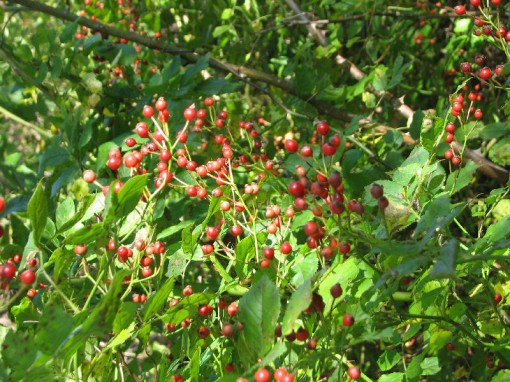
Don’t these berries look ornamental? And the birds love them. Such is the recipe for disaster, for these are rose hips of the invasive Rosa multiflora. This shrub is growing on the bank of the seasonal brook that borders the northern side of our property, right before it narrows and becomes easy to cross at the top of a hill. As you cross the brook at this point, you can look back down the slope and watch the water spill over the rocks. I used to dream of sitting on a bridge and enjoying the view, which I would enhance with ferns and native flowers planted into the steep bank. But it took a mere decade for this little glen to fill up with the thorn-infested brambles, which I’ll have to remove before I can ever realize my dream, and I’ll have to be eternally vigilant ever after. Don of An Iowa Garden has been working on eradicating this shrub, and it sounds exhausting.
After crossing the brook I continue to walk alongside it, stopping every couple of yards to disentangle myself from the thorns, until the brook and I part company and I enter the poplar grove.
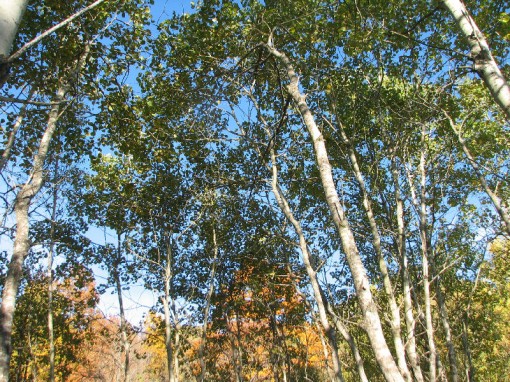

Populus tremuloides is known as popple, small-toothed aspen, and, most commonly, quaking aspen, but we just call it poplar.According to Janine Benyus, writing in The Field Guide to Wildlife Habitats of the Eastern United States
, poplar is a pioneer tree, “coming in after a disturbance and preparing the ground for yet another kind of forest.” Poplars are regarded as weeds by those who evaluate trees for their commercial value, but their white trunks and fluttering leaves are beautiful, and I am glad to have a stand of them. Not much besides asters seems to grow beneath their dappled shade, probably because the earth is knobby with their roots.
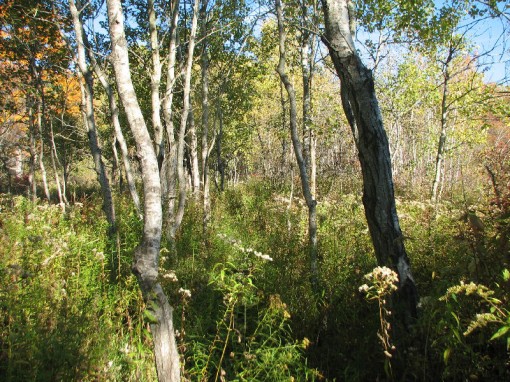 We’re going to walk down this path through the poplar grove towards that red gleam in the distance. (If you can’t see the spot of red I’m talking about, try clicking on the photo for a closer view. It’s just about in the dead center of the photo, but I have to admit it’s pretty small.)
We’re going to walk down this path through the poplar grove towards that red gleam in the distance. (If you can’t see the spot of red I’m talking about, try clicking on the photo for a closer view. It’s just about in the dead center of the photo, but I have to admit it’s pretty small.)
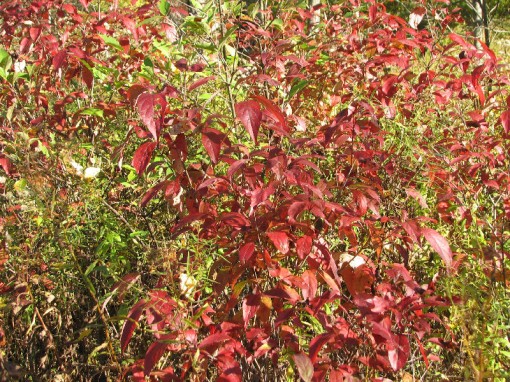
This is the brilliant red that was drawing my eye. Believe it or not, this is called gray dogwood (Cornus racemosa), but that’s because there’s another shrubby dogwood that has red stems, while the stems on this one are–you guessed it–gray. What I really like about this shrub is that it holds its white berries on red stems, as in the photo below:
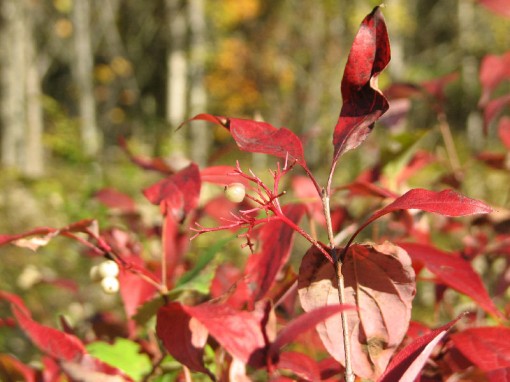
As a matter of fact, another name for this shrub is red-panicled dogwood, but that is kind of a mouthful. In some years, the leaves drop before the berries are eaten, and the contrast of the berries with their stems against a thicket of gray bark is quite dramatic. Moving beyond the dogwood, I enter the woods proper and walk past a huge fallen evergreen that I nicknamed “The Playground Tree” for its ability to become a pirate ship, an army tank, a rocket ship, or anything else massive and climbable. But while it served the elder half of my offspring well, it is now too decomposed to amuse the younger ones much. Further up the path, we come to what is for me one of the main reasons for a traipse up the hill in autumn:
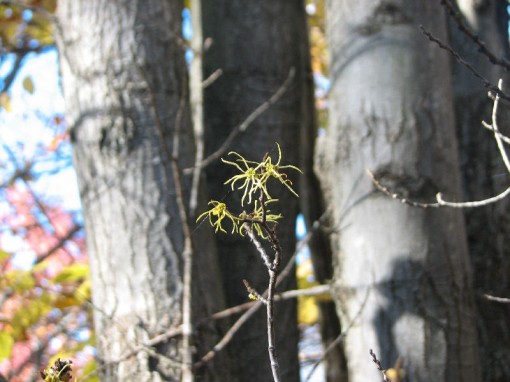 These are blossoms of the native witch hazel, Hamamelis virginiana. The first autumn we lived here, my husband took me up in these woods. He was obviously looking for something, but I couldn’t figure out what. Finally, he stopped and said, “Look up.” There before us was a rather large witch hazel completely spangled with the feathery blossoms. I was enchanted. It looked like stars had fallen and gotten caught in the branches.
These are blossoms of the native witch hazel, Hamamelis virginiana. The first autumn we lived here, my husband took me up in these woods. He was obviously looking for something, but I couldn’t figure out what. Finally, he stopped and said, “Look up.” There before us was a rather large witch hazel completely spangled with the feathery blossoms. I was enchanted. It looked like stars had fallen and gotten caught in the branches.
Every year I walk into the woods this time of year, looking for that special tree, but I never find it. Most years, it seems, the main flush of witch hazel bloom occurs while the leaves are still on the trees. But also, I think, that particular witch hazel grew on the neighbors’ land. Still, the romance of it calls to me every year.
Another interesting thing about witch hazel is that last year’s seeds are dispersed at the same time as this year’s flowers. Here you can see seed capsules and flowers together:
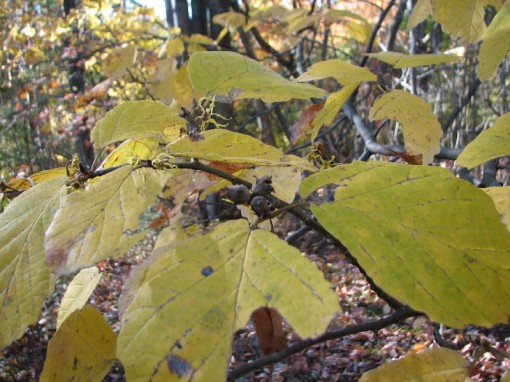
Eventually the path through the witch hazel grove bears right and joins the main path, which starts at the house and goes through the field, straight up the hill. The main path forks and circles around to rejoin itself.
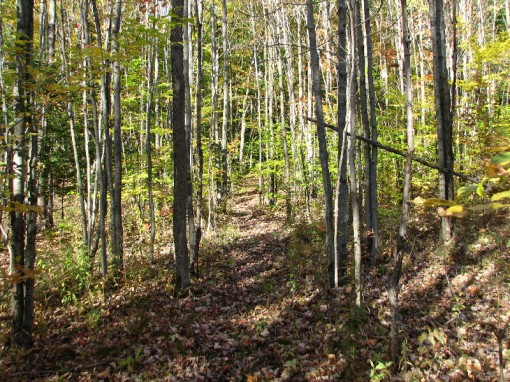
At this point I have taken the right fork and have gone about a third of the way around the loop. In late spring this area is carpeted with the native cranesbill (Geranium maculatum), but what strikes me today is the brilliant, almost fluorescent green of the beech leaves (Fagus grandiflora), sharply contrasting with the yellows and russets of the other trees. The beech leaves will eventually fade to tan and remain on the tree most of the winter. I find this annoying–don’t ask me for a rational reason. I feel like autumn is the season for the leaves to color and drop, and in winter the trees should be bare. The beech is just procrastinating and ruining the spare elegance of winter. It just looks messy. After I make my way down this section of the path, I’ll be turning left and starting back downhill.
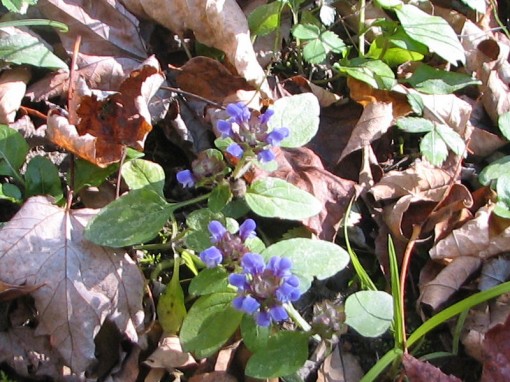

Here’s a little jewel in the leaf litter. I’m pretty sure it’s Selfheal or Heal-all (Prunella vulgaris), though in most pictures the flowers aren’t such a saturated hue. It’s not a native plant. In fact, I found the most information about it in Weeds of the Northeast
by Richard Uva, Joseph Neal, and Joseph DiTomaso. Presumably it is a straggler from the days when this area was pasture.
We’re almost all the way around the loop, and fast approaching the fork that will join us back to the main path. Hmmm, what have we here? It appears to have been erected by the juvenile form of
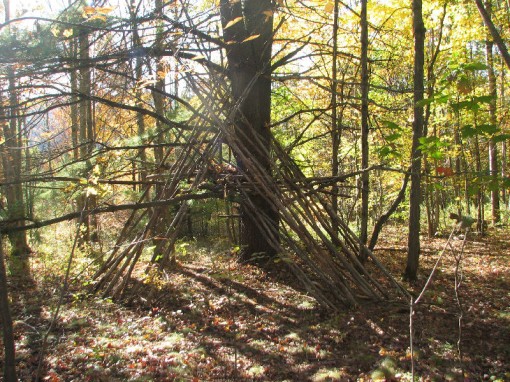
Homo sapiens. This is probably what my nine-year-old son was talking about when he said he was building a hut in the woods.
The path moves more steeply downhill, and I have to pay attention to my footing as I retrace my steps. I pass the beginning of the path to the witch hazel grove, but I keep to the main path, for another romantic destination lies up ahead.
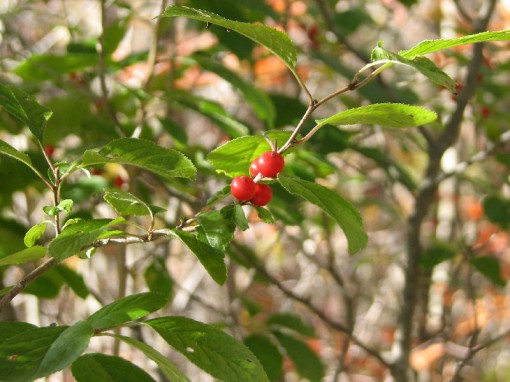
This red-berried shrub is a native; do you recognize it? I had to look it up when I got home, only to discover I’d planted five of them just this spring. Sheesh. Since this is a fruiting female, there must be a male shrub nearby, but I didn’t see it. But male and female winterberries is not what I meant by romantic.
This is romantic:
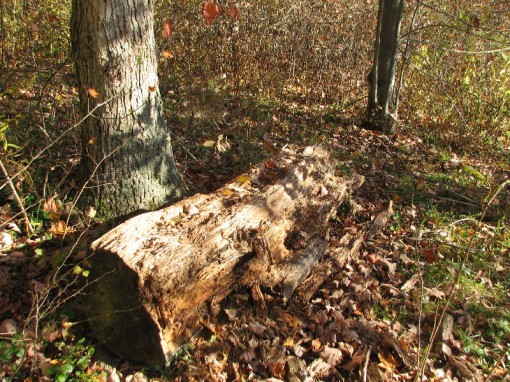
I know, you just can’t see it. This log is under an oak tree, and from this log there used to be two views: one straight ahead, looking over our field to the house and then the hill beyond, and one to the right, a view of distant hills. (I said “used to be” because saplings have grown up and obscured both views. I’ll have to see about getting this remedied.) Many years ago I wanted a bench to take in this view with my beloved. I’m not sure whether we couldn’t afford a bench, or the price just seemed disproportionate to the quality of the benches we found, but, instead of buying a bench and carrying it up the hill, my husband chose to walk to the top of the hill. He cut down the widest diameter tree he could find, and cut a bench-sized length from the bole. Then, with the help of our oldest boys, he rolled, heaved, and otherwise finagled it down to the base of the oak tree, and somehow halved it lengthwise, to make a bench. We walked up the hill and sat on that bench many a fine evening, and I’ve often enjoyed the views with friends as well. But as the log decayed it became less comfortable to sit on, and for other reasons my husband and I no longer walked up here together. But I think I will have to figure out exactly which saplings need to be thinned out, and perhaps I can find a rustic, lightweight bench to replace the log with. This is a grassy area hedged in with shrubs and saplings, and gives the feel of a sheltered room with a great view:
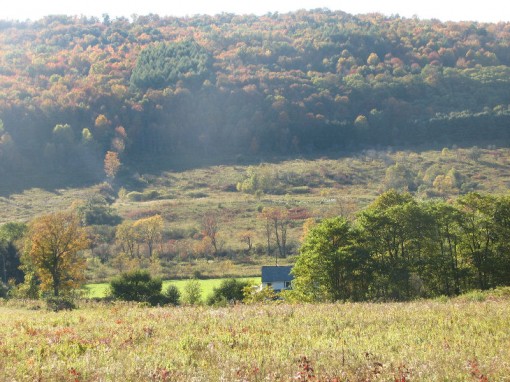
See what I mean? What looks like a lawn in the front of our house is actually the field across the street. Beyond the field you can see a row of scattered trees that marks the brook that runs through our valley, and then the opposite hillside rises up before you. When I take people up the hill the roundabout way through the Secret Garden, and save the field for the return trip, this view always takes them by surprise, which of course I enjoy. Wild columbine (Aquilegia canadensis) blooms here in the early summer, and asters are blooming now:
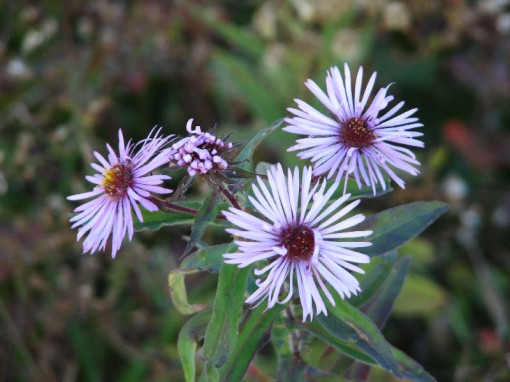
This one struck me as markedly different from its brethren in its pale flowers. I’m not sure if it is a different species, or just a variation of one of the other kinds growing here in profusion. It looks more purple here than it did in the field when I snapped the picture.
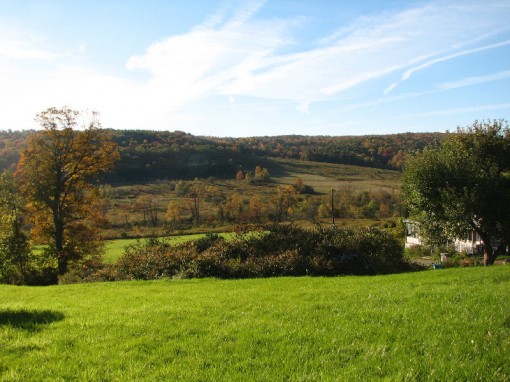
The vegetable garden is at my back as I’m looking toward the opposite hill. I include this photo mostly so you can compare it with the second photo in this post, giving you a better idea of just how much the fog was obscuring. In Justin’s photo the view is a little further back, and you can see a bit of the vegetable garden on the right. The same maple is in both photos, though it is tinged orange in mine, and the same mound of Polygonum cuspidatum is visible, though in my autumn photo it looks like a heap of brown, the leaves burnt by frost. That mound of Japanese knotweed obscures the foundation of our old barn. I decide to go down the hill behind the barn to check the progress of some colchicums, but wait–what’s that noise?
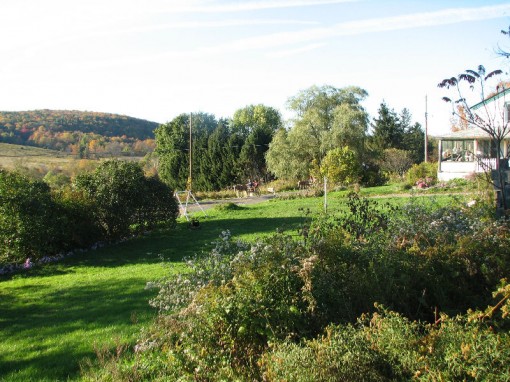
You couldn’t hear it like I could, but did you see it? Look closer:
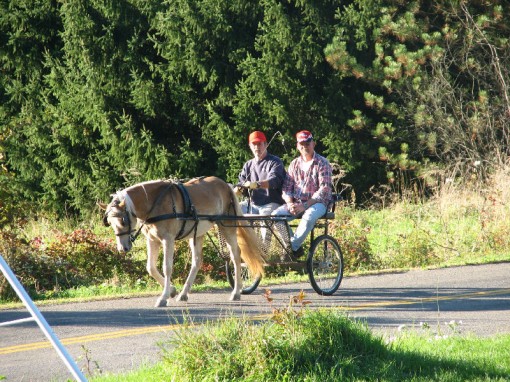
Just the neighbors, out for a Sunday drive.
Now, where was I? Oh, yes, that colchicum. It’s finally bloomed:
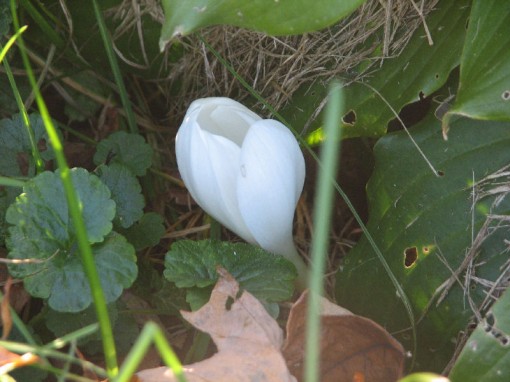
This white form seems to bloom much later than its pink counterparts, and much later than the other white colchicums planted in this bed. All the white colchicums that I have seem to be a very pure white, beautiful and dramatic against dark-foliaged ground covers.
That was my walk in the woods. I hope you enjoyed the scenery, and maybe even learned a little bit.




I love this post, I miss the chanign seasons being down here in Florida so it’s great to be able to check out all these other fantastic Blogpost with pics that do!! I miss riding too out in the country, wish I been in the carriage too!!
.-= Brushpile´s last blog ..Dragonfly Lady on Waterwise =-.
Kerri, I can certainly see how a native of Australia would have trouble with an upstate NY winter. I imagine it was a huge adjustment at first. The wind has really been blowing here, too, and it’s been dark, dreary, and drizzly for what seems like forever. There were flurries this morning as well! There is such a difference between the first half of October, when I took the walk featured in this post, and now. I’m glad I went when I did. You had quite a nice fall foliage post not too long ago, and I remember thinking that I had equally good views around here. You inspired me to take the camera along, and with all this encouragement, it’s clear I’ll have to do it again.
I came home from work and sat with a cup of coffee reading your post. The wind feels like it’s straight from the Arctic today, so an inside walk was very welcome 🙂 I’ve thoroughly enjoyed it Kathy, and learned some things too. The photos are a welcome addition to help us get an idea of your lovely location. I enjoyed your daughter’s comments, and love that your husband put that log ‘bench’ up on top of the hill. The woods are always such a fun place for kids. In their growing years ours spent a lot of time in our woods too, using their imaginations. Thanks for taking us along!
Glad you stopped by, Zoey. I have to say I was thinking of you as I was uploading all those photos, since you’ve said more than once that you think a blog should have lots of pictures!
Kathy, Thank you so much for that wonderful journey through your 14 acres. I so enjoyed the story of the bench your husband made from the log and put at the base of the oak tree.
That is one glorius view!
How lucky you are to live in such a peaceful & beautiful area.
Kim and Jenn–Owen admits that two of his older brothers (ages 11 and 13) helped him with the construction of his hut. He really appreciates your compliments.
That’s a handsome little horse!
(http://www.kyhorsepark.com/imh/bw/hafling.html)
I envy your little brook and woodlot. Sigh. Such a great place to raise your kids! (I too, think the ‘hut’ has great promise)
What a wonderful walk… I feel like I need to sit in front of a fire with a mug of hot cider now. 🙂
By the way, I must comment that if that structure was indeed built by a tribe of 9-year-old homo sapiens, they must be a rather precocious subspecies. That looks like the beginnings of a rather advanced hut!
Land rich and house poor, that’s us. Though out in the country, fourteen acres isn’t considered a lot. It’s actually half of what originally came with the house, and probably the smallest of the original homesteads on this road. Of course, we have our share of ranch houses on one acre lots along this road now, and almost all the still-standing barns now house horses for recreation instead of cows for income. It’s still more rural than suburban, but whether you’d call it farming country is debatable.
The idea of owning fourteen acres, along with the wonderful tour, has left me speechless and in awe.
Annie at the Transplantable Rose
Judith–I’ve enjoyed “walking” with you around your garden as well. I’ve always been a writer at heart, but I’m finally starting to realize that photos have their place. It does seem to take a lot more time to get just the right photo, crop it etc. appropriately, and place it in the best spot in the text. This post you were reading took me the better part of the week, but of course I had other things to do as well.
Cynthia–I would love to have you here to take another walk, anytime of year!
How I remember a spring walk in the woods with you (1992?)! I felt so alive traipsing through your woods and Secret Garden. The view is still gorgeous. Thanks for taking me along again for a tour in 2006!! I appreciate Talitha’s comments: she has an interesting perspective on the trees that hold on to their leaves. Of course I simply miss all the beautiful colors. The autumn color around my neck of the woods is rather drab.
I have enjoyed walking with you. I’ve learned some things I wasn’t aware of. Witch hazel–“that last year’s seeds are dispersed at the same time as this year’s flowers.”–I find that interesting. I like the hut! I feel as you do about trees who can’t let go of their leaves…but I do like the sound beech leaves make in the winter–they sound like chattering wind chimes to me. You have a beautiful walk with not only a close view in the woods, but an expansive view outside of the woods. PS I refer to Weeds of the Northeast too–a very useful book.
That’s so funny, Mom. I love how the beech and oak trees keep their leaves all winter!
In the case of the oak, I think it stems from a story I read as a kid. I don’t remember all the details, but it had something to do with Wicked Old Man Winter being detirmined to ruin all Lovely Lady Summer’s work, by forcing all the trees to loose their leaves. The oak was the hero of the story, because no matter how Old Man Winter blew, the oak clung to his leaves. Somehow I think it was tied in with that if all the trees did loose their leaves, than Spring could never come. So I always think of oak leaves on the trees as a defiance of winter and a hope for spring; I like them.
In the case of the beech, I actually think they become quite elegant. It’s true that at first they turn a rather dull and boring tan, but after that, they change. All the fall rain turns them transclucent and papery thin–almost more of a cream, or antique white in color. These contrast beautifully with the bark around them, especially after a rain–the rain darkens all the bark, so you have a cream and almost black contrast–very striking, and beautiful in an almost haunting way. Beech leaves are one of my favorite after-everything-is-dead things to look at.
In winter, after there is a deep cover of snow, these little white flags rustle in the breezes. I suppose after describing them as white flags, one would assume I meant they are surrendering to winter; but actually, they tend to remind me of the soldiers at Valley Forge–bandaged and battered, but holding out till Spring.
And, if you have never seen it, watching the beeches get their leaves in Spring is a true treat indeed. I spent a lot of time admiring the whole process this Spring.
(As you can see from Mom’s picture, the beeches we have are all still short, slim saplings. I think someone told me that a terrible blight killed off all the beech trees years ago, and these ones here are a new growth–the only kind of beeches around now. At any rate, these trees are still so small that the are only about as tall as me, so examination and apprecitation of their leaves is very convienent.)